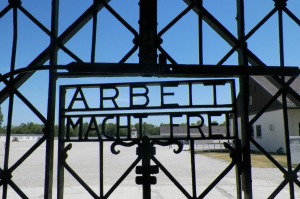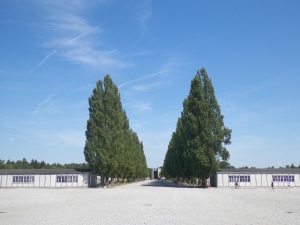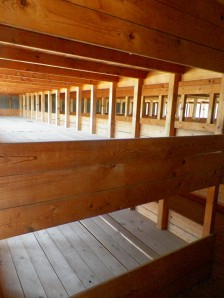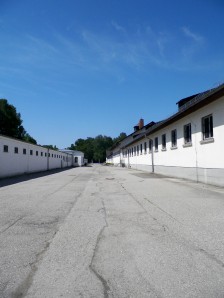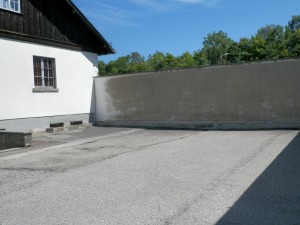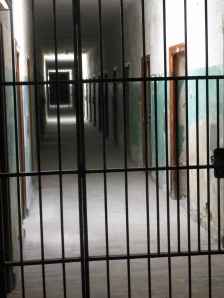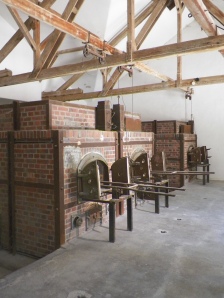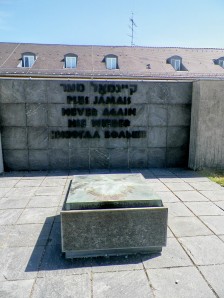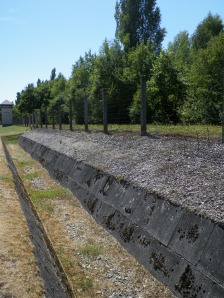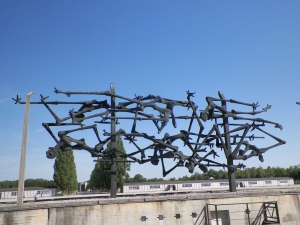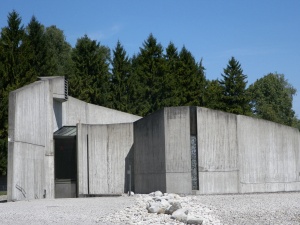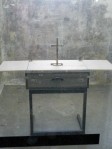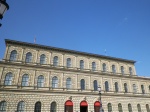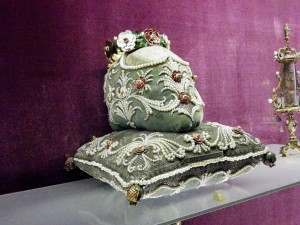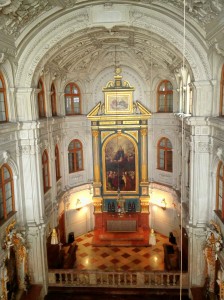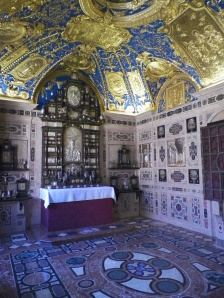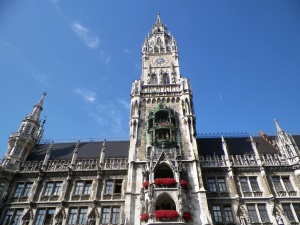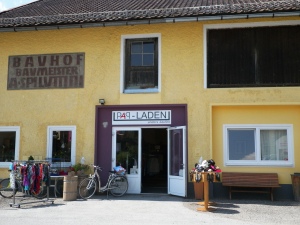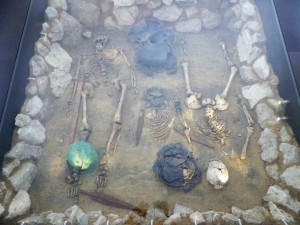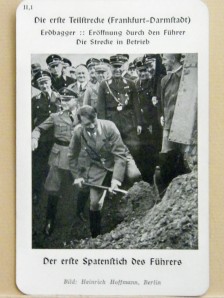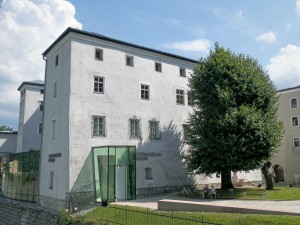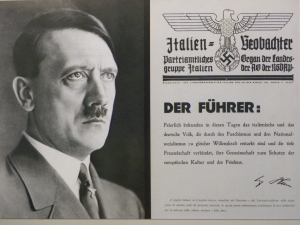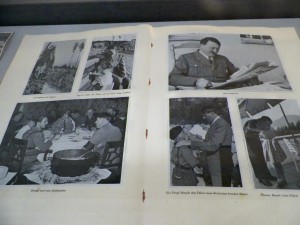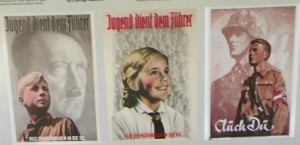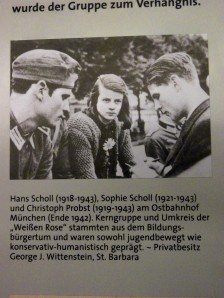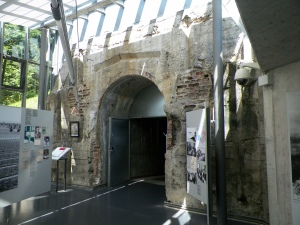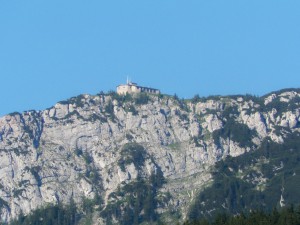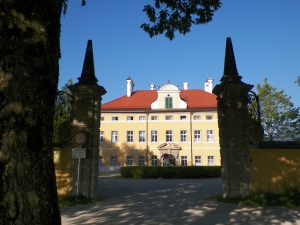We set off this morning (8/5/13) for Dachau. I was really looking forward to this trip, as morbid as that sounds, as I have had an interest in the Holocaust since I was in junior high. Finally, I had the opportunity to be there in person and hopefully grow in my understanding of the experience.
I had been interested to see on the website that the time they recommended for you to stay at the site was “All day.” Being there, I can easily see why they stated this. We opted to take the English tour for 3 Euros each (Parking was also 3 Euros for the day), and let me say, the tour was a worthwhile investment. (Mom and I each gave our tour guide an extra 20 Euro–she was amazing–and a volunteer!)
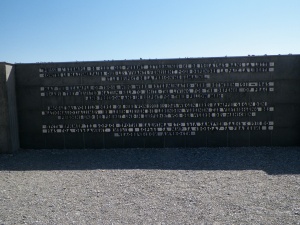
“May the example of those who were exterminated here between 1933 and 1945 because they resisted Nazism help to unite the living for the defense of peace and freedom and in respect for their fellow man.”
Dachau was also a model camp in many ways. First, its structure (rows of barracks with a central roll call area) was copied in all the other concentration camps. Second, this was the camp they showed off for propaganda reasons. The Red Cross even visited 3 times, and made glowing reports about the camp. The only problem is they were shown the SS officers in prisoners’ clothes in the “Living Room” area of the barracks, drinking, laughing, and playing cards, while the real prisoners were away at work.
Initially, though, before the war broke out, Dachau was not “that bad,” though as early as 1935, there was a jingle people used to say, “Dear God, make me dumb (silent), that I might not to Dachau come.” In 1933, the commandant Hilmar Wäckerle seems to have been a good man. Prisoners worked two days a week in a factory (usually BMW or other car manufacturers who paid the SS for the use of the prisoners, especially once the war preparations started as their labor force had been decimated due to military training.) These factories were largely the reason Dachau was one of the first to “vote brown.” The business generated by the SS and the “free” labor of prisoners must have been a hard offer to resist. Unfortunately, like many people today, they were willing to vote for whichever candidate best lined their pockets instead of considering the principles and character of the person in office. Prisoners might also be hired out to farmers in town. Those who worked on farms often were healthier because they received rations from the farm, but the other prisoners received a piece of bread, butter, and soup for the day, and could buy other items at the canteen. Additionally, medical staff was on hand to deal with any prisoner who had been injured or was infirm. Wäckerle had a little over 50 men to a room, and each bed had dividers between it and the one next to it. They were a meter wide and two meters long. At this time, there was a 99% survival rate in the camps. Since this was a prison and a camp for political prisoners, occasionally, those who had served their terms were released. Those who did not survive were usually the ones interrogated for information or charged with high treason. All of that changed when Theodor Eicke took over. Eicke, who would eventually be placed over the entire concentration camp system, was a World War I veteran whom Himmel rescued from a psychiatric ward, where trouble with a local had sent him on the charge of being a “dangerous lunatic.” I’d say they had him pretty well pegged. He instituted a series of changes that gave the SS full range for brutality. Prisoners could be shot for disobeying an order, whether it came from an SS officer or the kitchen staff. He also instituted punishments such as having a prisoner stand on a chair, placing the prisoner’s arms behind his back, tying his wrists to a rope that was suspended above him, and pulling the chair away, thus dislocating the shoulders, or worse. Unfit to work, the men were usually then sent to other camps to be killed. Another punishment was essentially an extreme corporal punishment. The prisoner would lean over a table, while an SS guard (or a family member if one was on hand–chosen as a dual punishment), would beat him 25 times with a whip supposedly made of a dried ox penis. This was designed to humiliate the prisoner even further by implying they weren’t even worth a traditional whip. The prisoner had to count in German as he was being whipped. If he didn’t know German or stumbled on the numbers (or passed out), the count began again. Also, guards had prisoners do menial tasks that would steal the less than 5 hours a night they had to sleep (usually 3 or 4). They had to polish the floor until it shined, make their beds so the checked squares were opposite from one bed to the next, forming a continuous pattern, or pull all the brown and yellow leaves off of the trees lining the roll call area in the fall.Additionally, Dachau accepted more prisoners, and expanded the camp so the living conditions changed. Rations were cut approximately in half. Beyond that, beds were made smaller and with more people in them. (By the end of the war, there were three men to a bed less than a meter wide, sleeping head to foot.)
Because of these cramped conditions, disease was became rampant, so much so that SS guards refused to work in the barracks for fear of catching the diseases. Rooms and prisoners were disinfected, and conditions improved slightly, but never fully. One tour member asked how many concentration camps there were. Franziska explained that this is a difficult question to answer because, “What defines a concentration camp? A munitions factory (Like in Schindler’s List) utilizing prisoners can be considered a concentration camp–so can a farm with prisoners working it, or the area of land where they’re forced to sleep because the camp wouldn’t invest in barracks. The numbers are tricky.”I was not aware that Dachau was an entirely male camp until 1944 (aside from the 7-13 female prisoners kept in “The brothel,” for obvious use.) Men were granted visits to the brothel, glasses, or boots in exchange for giving information about another prisoner. Fewer than one percent of the camp ever received such a bonus. Most who did chose the brothel because it was secret and didn’t advertise they had ratted someone out. Another way the Nazis kept resistance down was by constantly rearranging the barracks. Nationalities were mixed and parts of barracks were moved regularly in order to insure that no prisoners spent enough time together to really form bonds. This made the experience even more lonely and difficult.
From the barracks, we moved into the area where roll calls were done. One tour member asked Franziska how the Germans felt about this, while another questioned how strange it is that a site of such horror is a tourist attraction. Franziska answered both questions, giving a perspective I had never considered. She talked about the fact that Germany focuses on the Holocaust so much because the rest of the world continues to punish them for it. She explained that as a child in Hamburg, her school took her on trips to concentration camps 8 different times. In one instance, her teacher made the children stand motionless for 2 hours in the roll call area so that they would have a small taste of what the prisoners experienced. Even today, when she drives into another country, her car is not safe for 15 minutes before someone will have scratched a swastika on it because her license plate has the DAH of Dachau. She’s been refused service in restaurants in Italy because they saw her drive up in a car with DAH on it. Like so many cases of racism, each person assumes the other is racist, which is a form of racism in itself. I think this is the biggest “take away” for me. I remember being in high school when the Berlin wall came down. I remember the fear people felt because of what a unified Germany would mean to the world (while, in fact, the unification of Germany made it harder for those in the West because they had to absorb and remedy the problems of the East.) That fear led many to judge the German people unfairly. Franziska went on to explain that she has heard former SS leaders give school talks with great remorse for the role they played. They explained how they had been convinced that they were doing the right thing. When you understand that German students started math problems in elementary school that said something like, “If a handicapped person costs the government $30,000 marks a year, how much will the government spend by the time that person is 30?”, it’s easy to see how some of the thought process came to be. In point of fact, there’s a larger Neo-Nazi group in America than in Germany. And many items that have disappeared from Dachau (Shower heads, faucets, etc.) have turned up on Ebay in America, Canada, and Australia. Additionally, the Allied forces were not entirely innocent. Some shot surrendering SS members, even in hospitals as well as family members in the SS area outside the camp. Others used extreme forms of interrogation and forced soldiers to confess to crimes they may not have committed. (These crimes were uncovered in 1991 and had been covered up by General Patton.) I’m sure each side thought they were doing their duty, or avenging others, but it does bring to mind the question of what is justifiable force in dealing with an enemy–a question we still haggle over today. From the roll call area, we went to the shooting wall. This is the place where political prisoners were executed. Interestingly, because Dachau was so close to a town (The SS quarters and their families are just past the prison wall), the officers used to shoot prisoners on Sundays when the church bells were ringing and the noise wouldn’t be noticed. Those accused of high treason, which interestingly enough included SS soldiers who had helped prisoners or tried to let them escape, were executed immediately.Just beyond the shooting wall is the holding cells for “Special prisoners.” The prisoners thought of this as being a safe house from which no one returned. What I mean by that is the prisoners were given decent food, didn’t have to work, and were kept alive–until new batch of political prisoners came in to “replace” them. The special prisoners included men like the former chancellor of Austria and several prominent clergy members.
Having finished our course in the life of prisoners, we walked over to the crematorium area. While the crematorium was used at Dachau to eliminate bodies of those who had died of disease or starvation, the gas chamber located there was never used. One interesting fact is that the crematorium was located outside of the camp and facing east. This way few of the prisoners and none of the town knew what was going on. Those prisoners who worked in the crematorium were killed every three months to keep news from leaking. Eventually, though, use of the crematorium stopped as well, due to the coal shortage. It is for this reason the U.S. soldiers who liberated the camp found 11,000 dead bodies there and in almost 30 rail cars outside the camp. Quite a staggering number! Because they were unable to identify the bodies of the dead, they cremated the bodies and put the ashes in a mass grave with the monument of a coffin and the sign “Never Again” in five different languages. (I was touched by the fact that as we walked by it, one of the young men in our group added a stone to those already on top of the monument as a sign of remembrance–he couldn’t have been much over 20. Please note, the monument is just in front of the museum building which used to be the former check in area and showers (real ones). The roof in the picture belongs to this building, not the monument.)From the area of the crematorium, we walked back over the bridge and stopped beside the electric fence. Here, we heard the stories of why no escape from Dachau ever succeeded by going over the fence. Between the barracks area and the fence is a strip of grass, nicknamed the “Green zone.” Any prisoner who stepped in this area would be shot immediately. They were not shot in the head, which would have been an easy death, but either in the shoulder or the stomach, which were slower and more painful. Past the green zone, there is a ditch about 5 feet down and 6-8 feet across.
On the other side of this ditch was first gravel, which would have caused a noise to alert the guards, and then on top of the gravel, coils of barbed wire which were arranged in approximately 1 foot squares, all electrified and going up higher the closer one got to the fence, which was also electrified. Franziska informed us that it is because of this that prisoners who wanted to commit suicide, usually did it as they were returning to the camp by throwing themselves against the fence from the outside.This referenced a monument she had shown us earlier. After the war, Dachau had been used as a holding place for German prisoners associated with war crimes. Then, it became a place for refugees. While it was still being used for this purpose, a contest was held among survivors to create a monument to be used in Dachau. Sixty-five entries were made. From these, this sculpture of Nandor Glid’s was chosen.
Glid himself had not been at Dachau, but instead at a labor camp where he had joined the National Liberation Movement to fight against the Nazis, and was later wounded. He chose the design for his sculpture after talking to numerous others who were at Dachau. One of the most striking images they had communicated was this fact that some, wanting to choose the time and method of their death instead of having the Nazis do it for them, had chosen to throw themselves into the electric fence. The Nazis would leave the bodies there until the rotted, which in winter, could be months, so workers would have to pass by the bodies on their way to work. That image was burned into the memory of anyone at Dachau. That is why the judge, himself a survivor of Dachau chose this statue. In it, the hands of the victims make the barbs for the barbed wire fence, and the center person (with his head down) forms the swastika with his body.Just inside the fence by the green zone, Franziska also pointed out 4 different church memorials. To the best of my knowledge, Dachau is the only concentration camp with religious monuments for faiths other than Jewish. At Dachau, there is the Russian Orthodox memorial, a Protestant Memorial, a Catholic Memorial, and a Jewish Memorial. Additionally, there is a monastery just outside the wall.
These memorials are due to the fact that a number of the prisoners at Dachau were members of the clergy who took a stand against what Hitler was trying to accomplish. One interesting item I saw in the “Special cells” was a portable altar to be used by the clergy for holding religious services. It makes me proud that almost 3,000 clergy took a stand against the evils of the Nazi party.Finally, we made one last stop to see how Dachau was laid out at the time, and compare it to it’s use today. Interestingly enough, the former SS area and training facilities are now utilized by the Dachau police. Apparently, they have gone to great lengths to preserve what they can as a remembrance of the crimes committed here. Franziska told us one last story here. She had recently met a survivor in his 90’s. He shared that he used to work in the area of the camp that made honey for the German officers. He explained that he used to pee in the honey as his own form of resistance. So, a number of German officers received “tainted honey” from Dachau. All in all, our tour had been an amazing experience!
We then headed to Munich to the Residence Museum and treasury. Driving around Munich was every bit of the insanity predicted, but we finally managed to find both the Residence and the parking garage right beside it. (Max-Joseph Platz is super convenient, but charges 4 Euro for the first hour and 3 Euro an hour for every one after that.) The Residence is an unimpressive façade compared to some of the other places we have visited. However, this was more the seat of government for the Bavarian rulers and the place where the royals stored their treasures. Here, at last, was a castle in which you could take pictures. Unfortunately, the lighting set up around the area makes getting a good shot extremely difficult. We started out in the hall of ancestors. Once can immediately feel the weight of responsibility a young ruler must have felt as he or she walked past all of those eyes staring down at them. There’s even a portrait of Charlemagne and a gigantic family tree. It was an incredible contrast to see the gold and glitz of Munich right after the brick and concrete of Dachau.From the hall of ancestors, we went into one of the areas displaying the treasures of the king. Here we were confronted with a number of reliquaries. Reliquaries are one of the most interesting things for me to see.
As reliquaries were supposed to bring blessing to the one who owned them (and even miracles), the king was expected to have the largest collection. While I know historically a number of reliquaries exist that did not contain anything close to what they are supposed to house, there were a few here that were especially interesting. First, there is the ever popular piece of the cross of Christ. Apparently, a whole forest of these were sold at the time. They also had the typical bones of the martyrs. But the things that most interested me were two fold. The first was a crystal casket containing the skeleton of a small child, supposedly one of the children murdered under Herod’s orders. While I think carrying around bones of any kind is morbid, the skeleton of a child would especially creep me out. The other curiosity is the skull of John the Baptist. What interested me most about this is the way they decorated it and put a crown on it. Still, you’re carrying around someone’s skull!From this point we took in the Chapel for the public. What interested me here is that the royal family sat in the gallery (the spot from which I took my picture), while the rest of the congregation sat below. I guess they wanted to keep an eye on things. Another odd thing is that the gallery area is in the back. Usually, if royals are seated above the crowd, they are often in a prominent position to allow the congregation to look at them. That is not the case here.
Additionally, just off the Gallery is an ornate chapel, which was the private place of worship for the king and queen. Maximilian I had it completed in 1607–interestingly, the same year of the Jamestown colony. It is a beautifully decorated area which definitely inspires worship.We left the chapel to go through a variety of the rooms of state. Here the royals conducted business of all sorts. What interested me the most is the themes of the room are incredibly religious in nature, from the room showing the law of God is higher than the law of men, to the room demonstrating the virtues a ruler should posses, to rooms that remind mankind of their command to subdue the earth. Unfortunately, many of these rooms were damaged during World War II, so the center paintings in each room no longer exist.
Finally, we left the splendor of the Residence (Residenz) and headed a few blocks downtown to see the Rathaus-Glockenspiel in Marienplatz. For once, we timed something exactly right and got there just in time for the 5:00 show. Since it only plays 2 times a day (Three times in the summer), this was a rare treat. This breath-taking 105 year old clock tower tells two stories from the 16th century. The first is of the marriage of Duke Wilhelm V to Renata of Lorraine. They have figures from each country who joust (the one from Bavaria always wins…). The second story is of the coopers who danced through the streets after the Plague. This is supposed to be a picture of loyalty during difficult times.With that, we called it a day, paid our 10 Euro parking bill, and headed back home. I must say the Alpine Club treats us like family. They’re always helpful and interested in what we have done for the day. It’s a great place to stay.
